Front Wheel Alignment -- Adjustment |
| 1. INSPECT TIRES |
| 2. MEASURE VEHICLE HEIGHT |
Bounce the vehicle up and down at the corners to stabilize the suspension. Inspect the vehicle height.
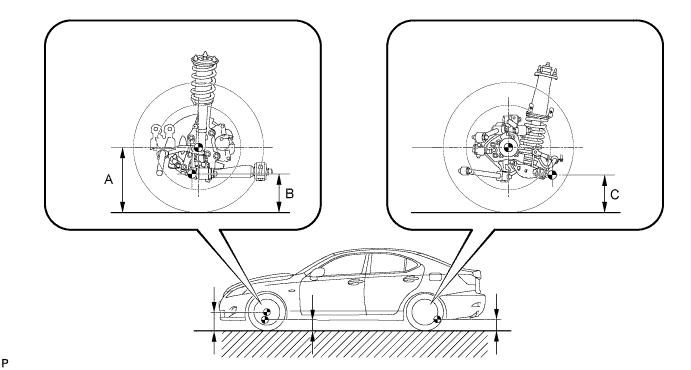
- Vehicle height:
4GR-FSE Suspension type Wheel size Front (A-B) Rear (C) normal 16 in. wheel 111 mm (4.37 in.) 212 mm (8.35 in.) 17 in. wheel 214 mm (8.43 in.) 18 in. wheel 220 mm (8.66 in.) sports 18 in. wheel 121 mm (4.76 in.) 220 mm (8.66 in.) 2AD-FHV Wheel size Front (A-B) Rear (C) 16 in. wheel 101 mm (3.98 in.) 222 mm (8.74 in.) 17 in. wheel 234 mm (9.21 in.) 18 in. wheel 240 mm (9.45 in.)
- Measuring points:
- A:
- Ground clearance of front wheel center
- B:
- Ground clearance of front center position of front suspension lower arm assembly front bushing installation bolt head
- C:
- Ground clearance of rear center position of rear No. 2 suspension arm bushing installation bolt threads
- NOTICE:
- Before inspecting the wheel alignment, adjust the vehicle height to the specified value.
- Be sure to perform measurement on a level surface.
- If it is necessary to go under the vehicle for measurement, confirm that the parking brake is applied and the vehicle is secured with chocks.
| 3. INSPECT TOE-IN |
Bounce the vehicle up and down at the corners to stabilize the suspension.
Release the parking brake and move the shift lever to the neutral position.
Push the vehicle straight ahead approximately 5 m (16.4 ft).(*1)
Put tread center marks on the rearmost points of the front wheels and measure the distance between the marks (dimension B).
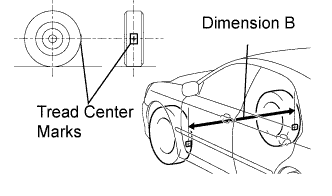 |
Slowly push the vehicle straight ahead to cause the front wheels to rotate 180° using a front tire pressure valve as a reference point.
- HINT:
- Do not allow the wheels to rotate more than 180°. If the wheels rotate more than 180°, perform the procedure from *1 again.
Measure the distance between the tread center marks on the front side of the wheels.
- Toe-in:
Toe-in (total) A - B: 1.0 +- 2 mm (0.04 +- 0.08 in.)
- HINT:
- If toe-in is not within the specified range, adjust it at the rack ends.
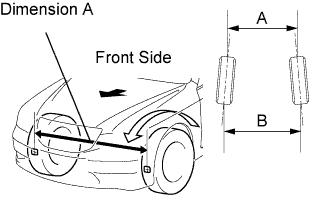 |
| 4. ADJUST TOE-IN |
Measure the thread lengths of the right and left rack ends.
- Standard:
- Difference in thread length is 1.5 mm (0.059 in.) or less
 |
Remove the rack boot set clips.
Loosen the tie rod end lock nuts.
Adjust the rack ends if the difference in thread length between the right and left rack ends is not within the specified range.
Shorten the longer rack end if the measured toe-in deviates toward the outer-side.
Extend the shorter rack end if the measured toe-in deviates toward the inner-side.
Turn the right and left rack ends by an equal amount to adjust toe-in.
- HINT:
- Try to adjust toe-in to the center of the specified range.
Make sure that the lengths of the right and left rack ends are the same.
Torque the tie rod end lock nuts.
- Torque:
- 56 N*m{571 kgf*cm, 41 ft.*lbf}
- NOTICE:
- Temporarily tighten the lock nut while holding the hexagonal part of the steering rack end so that the lock nut and the steering rack end do not turn together. Hold the width across flat of the tie rod end and tighten the lock nut.
Place the boots on the seats and install the clips.
- HINT:
- Make sure that the boots are not twisted.
| 5. INSPECT WHEEL ANGLE |
Put tread center marks on the rearmost points of the turning radius gauge.
Turn the steering wheel fully left and right and measure the turning angle.
- Wheel turning angle:
4GR-FSE Suspension type Inside wheel Outside wheel (Reference) normal 41°34'+- 2° (41.57°+-2°) 36°10' (36.17°) sports 41°26'+- 2° (41.43°+-2°) 35°56' (35.93°) 2AD-FHV Inside wheel Outside wheel (Reference) 41°42'+- 2° (41.70°+-2°) 36°22' (36.37°)
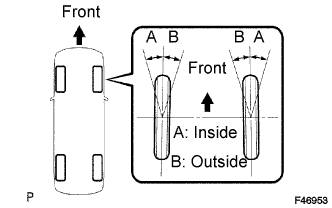 |
| 6. INSPECT CAMBER, CASTER AND STEERING AXIS INCLINATION |
Place a front wheel on the center of the turning radius gauge.
 |
Remove the center ornament.
Install the camber-caster-kingpin gauge at the center of the axle hub or drive shaft.
Inspect the camber, caster, and steering axis inclination.
- Camber, caster, and steering axis inclination:
4GR-FSE Suspension Type Wheel size Camber angle Caster angle Steering axis inclination angle Sports suspension 18 in. wheel -0°36' +- 45'
(-0.6° +- 0.75°)8°04' +- 45'
(8.07°+-0.75°)10°55' +- 45'
(10.92°+-0.75°)Normal suspension 16 in. wheel -0°23'+- 45'
(-0.38°+-0.75°)8°07' +- 45'
(8.12°+-0.75°)10°41' +- 45'
(10.68°+-0.75°)17 in. wheel 8°11'+- 45'
(8.18°+-0.75°)18 in. wheel 8°04'+- 45'
(8.07°+-0.75°)2AD-FHV Wheel size Camber angle Caster angle Steering axis inclination angle 16 in. wheel -0°11+- 45'
(-0.18+-0.75°)7°54+- 45'
(7.90°+-0.75°)10°29' +- 45'
(10.48°+-0.75°)17 in. wheel 7°45'+- 45'
(7.75°+-0.75°)18 in. wheel 7°38'+- 45'
(7.63°+-0.75°)
- NOTICE:
- Perform the inspection while the vehicle is unloaded.
- The maximum tolerance of the right and left difference for the camber and caster is 30' (0.5°) or less.
Remove the camber-caster-kingpin gauge.
Install the center ornament.
If the caster and steering axis inclination are not within the specified values after the camber has been correctly adjusted, recheck the suspension parts for damage and/or wear.
| 7. INSPECT FRONT SUSPENSION |
Inspect the front suspension member.
Measure the dimension between the center of the installation bolts of the front lower suspension arm.
- Standard:
- 692.5 to 699.5 mm (27.26 to 27.54 in.)
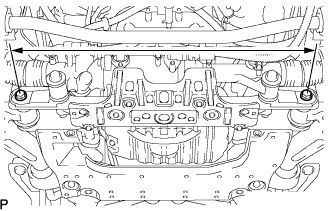 |
Inspect the front lower suspension arm assembly.
Remove the front lower suspension arm assembly (Click here).
Measure the dimension between the center of the front lower suspension arm assembly bush and the center of position A.
- Standard:
- 362 to 364.6 mm (14.25 to 14.35 in.)
- HINT:
- If the dimension of the front lower suspension arm assembly changes 2 mm (0.079 in.), the camber will change approximately 15' (0.25°).
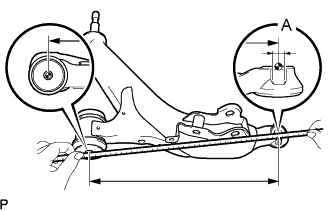 |
Inspect the front upper suspension arm assembly.
Remove the front upper suspension arm assembly (Click here).
Measure the dimension between the center of the front upper suspension arm assembly bush and the center of the ball joint stud.
- Standard:
- A:
- 241 to 242.6 mm (9.49 to 9.55 in.)
- B:
- 215.1 to 216.7 mm (8.47 to 8.53 in.)
- HINT:
- If the dimension of the front upper suspension arm assembly changes 2 mm (0.079 in.), the camber will change approximately 15' (0.25°).
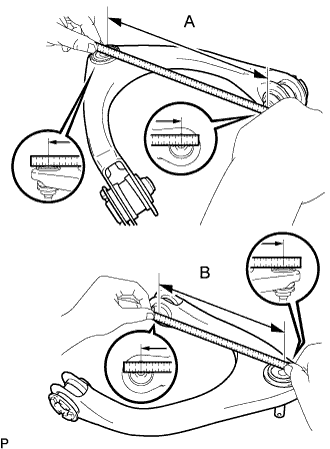 |